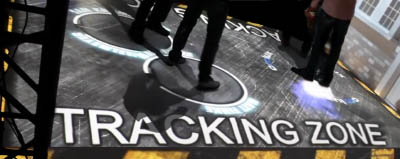Loading...
The ID Tag Tracker Input node consists of all settings related to tracking IR ID tags from Christie Digital Systems Germany. The node requires the enabled option "OptiTrack Camera Manager" in the Connection Manager. It is available in Widget Designer PRO and ULT edition. The tag configuration is included in the Widget Designer STD too.
|
Below the principle of ID camera tracking is explained whilst the next chapter covers the hardware and environment requirements. The very last chapter approaches tracking with moving lights (automatic follow spot) and how to set up your GrandMA console for it.
The general idea behind the optical tracking method with infrared cameras and infrared identification tags -short IR ID tags - is to locate a person or any object, identify it and track its movement. This can be done without any cables attached to the person / object as the tag is pinned on the tracked object and is seen by one or several cameras.

The tag is an active marker with an internal power source: in contrary to a passive marker it does not reflect but emits light itself which allows a higher luminosity (and hereby a maximum range) as well as more flexibility in your stage setup.
In addition to that it can be configured with an identifiable number. Thus it is possible to distinguish two objects from each other, even if they overlap and separate again. This is a huge advantage compared to other camera tracking methods. As well, it allows playful interactive scenarios. For instance it is possible to assign dedicated properties (e.g. content media or color) to dedicated persons or objects. As well, these properties can be shared or swapped if two objects meet.
Currently, you may track up to 256 different IDs. Several tags can be set up with the same ID. The maximum total number of trackable tags depends on the hardware system.
Another requirement in the tag development was allowing it to be hidden in scene pieces, costumes etc. whilst providing good handling on stage. We met this need by reducing the tag to the minimum size possible, the pure printed circuit board with an onboard power source. Furthermore, the tag can be used out of the box or it can be modified to suit individual needs. That includes different power and / or light sources, e.g. spatially divided from the tag board.
The Widget Designer offers a unique,self-developed tracking method that processes the camera data, allows user adjustments and provides the object's position. With a minimum of three cameras, it is possible to track the 3D position, that is the exact location in a 3D space, expressed through the X-, Y- and Z-position. It is also possible track only in two dimension ( i.e. a plane), for instance, if one axis does not change. This reduces the camera count to one and other hardware too.
The 2D or 3D data can then be send (through other Output nodes) to a Pandoras Box playback system, e.g a Video Layer. Alternatively or in addition, the data can be directly send to the MA PSN protocol and auxiliary tracking servers.
Besides the position tracking itself the Widget Designer offers the management of the tags properties mentioned above. To fulfill creative tracking scenarios you may adjust settings in the tracking node itself or combine it with everything else, the Widget Designer offers: from the command language and the entire nodes system to other tools and user-controls through to variables and functions. The combination of all this allow to program even the most complex logic.
Hardware-wise the IR ID tracking method requires tags, cameras, (a switch), and a PC running Widget Designer. The surrounding environment must be suitable. The next page explains more about requirements regarding hardware and the environment.